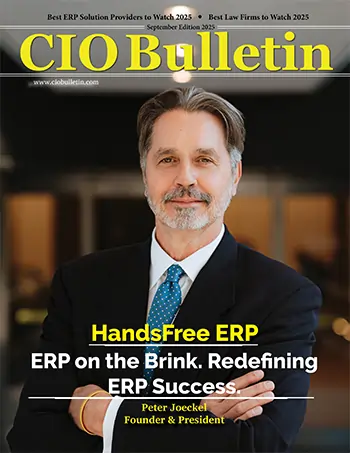Home Technology Software What is the impact of advanced...
Software

CIO Bulletin
01 April, 2024
The employment market has been significantly impacted by advanced technology, which has brought about both opportunities and challenges for businesses and employees. New professions and sectors, including social media managers, software developers, and data analysts, have been brought about by technological breakthroughs. These positions can pay well and provide job security, but they also call for specific expertise and abilities.
But as technology has advanced, many repetitive and routine operations have also been automated, which has resulted in labor displacement in several industries. For instance, human labor-intensive manufacturing tasks are now completed by robots, and chatbots and other automated systems are replacing customer support positions. Concerns regarding job security and the effect of automation on people's livelihoods have arisen as a result of this.
A plethora of variables, including the rapid growth of advanced technology, the growing influence of globalization, and noteworthy demographic trends, are contributing to a dramatic transformation of the nature of labor in the future. It is critical for people and organizations to be aware of and adjust to these changes as the job and educational landscapes continue to shift. This in-depth essay explores important data points and highlights some of the most creative firms that are leading the charge to transform the way that work and education are done in the future. Through analyzing the patterns and comprehending the ramifications, people and institutions can more adeptly traverse the developing terrain and capitalize on the prospects digital transformation offers.
Unquestionably, automation is having an unfavorable effect on the workforce and is fast changing the way we live and work. Automation can, however, have a lot of positive effects on the workforce, such as higher production and efficiency, but it can also have negative effects on employment, such as job displacement and the requirement for new skills and training.
Automation, driven by globalization, changing consumer habits, and tech advancements, is leading to worker displacement through labor reduction, process automation, and less need for human decision-making. Machine learning and AI are accelerating this by taking over tasks such as data entry and complex decisions. Additionally, the rise of e-commerce is eliminating traditional retail jobs as physical stores decline, with more businesses moving online and requiring fewer employees.
Goldman Sachs predicts that AI could take over 300 million full-time jobs, potentially replacing 25% of work tasks in the US and Europe, while boosting productivity and creating new jobs. This could lead to a 7% increase in global output. Up to 25% of jobs could be fully automated, with the majority of US and European jobs facing some automation. Educated white-collar workers earning up to $80,000 are most at risk. Forbes references a study suggesting AI could replace two million manufacturing jobs by 2025. McKinsey believes that by 2030, AI and tech advances might necessitate career changes for 14% of workers globally.
In order to meet market demands, staffing firms must constantly adjust to shifting organizational needs, technological advancements, and market conditions that change the in-demand abilities of skilled individuals. The majority of workers' employment has changed throughout time due to factors like globalization, digital transformation, and advanced technology —including artificial intelligence—is set to further modify these roles.
Although there is some relationship between the two strategies, reskilling and upskilling are very different. Upskilling is the process of training an employee with new skills relevant to their present position in order to improve their current abilities. There is still commercial workforce development need for new information, even though a position may not require it. Think of an IT technician who wants to take certification classes for recently released software, for example.
Retraining, on the other hand, equips present employees for a variety of digital transformation roles. It is possible that the roles they have been playing for a long time are becoming outdated. The corporation wants to keep these workers rather than replace them, lifelong learning even if there is less and less need for their existing abilities. As a result, the company can offer training so that these employees can start new careers. It is anticipated that employment agencies will be essential in tackling this transition due to the advent of artificial intelligence.
Technology and its effects on the future of work are among the most discussed topics in corporate forums and leadership consortiums job automation worldwide at the moment. Global leaders expressed concerns about how disruptive technological breakthroughs are becoming and how they might be one of the biggest risks to civilization at this year's World Economic Forum (WEF) in Davos.
There are many who disagree as these cries of workforce development terror spread throughout countries. For my part, I think that technological advancement and automation are really eliminating employment more quickly than innovation is creating it. Recent years have seen the emergence of whole new businesses, giving rise to offshore positions that were nonexistent a decade ago. Technology has brought about new industry disruptions that have opened up investment and employment opportunities.
Approximately 3.5 billion individuals, or more than 40% of the world's population, use the internet nowadays. They primarily use a smartphone that they carry around in their pockets to access the internet. This will undoubtedly alter not only our individual lives but also the corporate landscape. Significant changes in social institutions, as well as how individuals contribute to society and earn a living, have been brought about by massive developments in advanced technology.
The era of artificial intelligence (AI) is expected to bring significant changes to how we learn, work, and live. AI systems can process data and mimic intelligent behavior, including perception, learning, reasoning, prediction, planning, and control. If fully adopted, lifelong learning AI could deliver the productivity improvements that were expected from the IT revolution, potentially resolving the debate over Solow's paradox. While current data on AI's impact is limited, there is evidence that it can increase productivity and positively affect Tobin's Q, especially when used to enhance a company's capabilities instead of just automating tasks. AI is also becoming increasingly important in efforts to fight the COVID-19 pandemic.
The development and use of AI is changing the types of tasks employees do and the skills they need. This is leading to new job roles, with different pay, job security, training, job automation, and work hours. Some might be highly skilled, while others aren't. Gig jobs, which are done remotely over the internet, offer flexibility but can also lead to low pay, unpredictable hours, overwork, isolation, and exhaustion.
UNESCO's AI Recommendation promotes lifelong "learning to learn" and acquiring a broad range of skills because of AI's wide-reaching effects. AI is changing how we interact, learn, and process information. However, it can also cause misinformation and hinder our ability to make informed decisions. AI has the potential to deepen existing inequalities, create new ones, and threaten human rights and democracy.
Conclusion:
Notwithstanding these difficulties, advanced technology’s influence on the labor market has also produced a wealth of opportunities. For instance, remote work, which enables employees to live and work from anywhere in the world, is becoming more and more popular. Technology has also made it simpler for employees to seek freelance or gig employment and for entrepreneurs to launch their own companies.
In conclusion, advanced technology has undoubtedly affected the labor market, but it has also given rise to a wide range of options for both businesses and employees. Employees can position themselves for success in this ever evolving labor market by regularly upskilling and keeping up with the most recent technical advancements.
FAQ:
1. How has advanced technology reshaped job markets globally?
Labor markets can greatly benefit from advanced technology; digital talent platforms enable a more efficient matching of jobs and workers. Digital talent platforms could enhance the way that jobs and workers are matched, bringing efficiency and transparency to labor markets and possibly increasing GDP.
2. What are the key challenges faced by workers in adapting to technological advancements in the workplace?
Top Issues with Digital Workplaces:
3. What opportunities does the gig economy offer in the context of evolving job markets?
In the gig economy, gig workers are able to choose how much, when, and where they work. Those who appreciate work-life balance and want to balance their professional and personal obligations may find this degree of scheduling control very tempting.
4. How can policymakers address issues of inequality resulting from technological disruption?
Reskilling and Retraining: Concentrating on reskilling and retraining employees whose employment has been impacted by technological disruption is another strategy for responding to policy changes. This can be accomplished by offering training courses that give employees the know-how required to operate in developing markets.
5. What role do reskilling and upskilling initiatives play in preparing the workforce for the jobs of the future?
However, by making career-related investments in each member of your team through upskilling and/or reskilling, you'll produce committed and engaged workers. The evidence? According to 86% of CEOs, staff engagement increased when their digital training and education initiatives were introduced.







